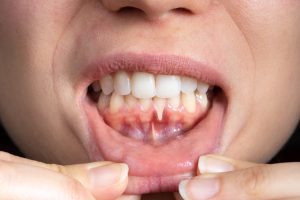Restore Your Gums for A Healthier, Lovelier Smile
At DiBartola Dental, our Bridgeville dental team understands the importance of a healthy, confident smile. Receding gums can not only affect your oral health but also impact the aesthetics of your smile. That’s why we offer gum grafting to address this common concern and restore the beauty and vitality of your gums. 
Dr. Wayne DiBartola and our experienced team are here to provide you with exceptional care and personalized treatment for gum grafting. Contact us today at (412) 221-9440 to learn more about how our advanced techniques and compassionate approach can help you regain the gum health you deserve.
What Is Gum Grafting?
Gum grafting, also known as gingival grafting and soft tissue augmentation, is a dental procedure that addresses gum recession, which can lead to tooth sensitivity and aesthetic concerns. It involves surgically moving healthy gum tissue, often from the palate, to cover and protect exposed tooth roots, improving both oral health and smile aesthetics.
This procedure is essential for preventing further damage and restoring the natural strength of your gums. If you’re considering gum grafting, our team at DiBartola Dental is here to provide guidance and answer your questions.
Benefits of Gum Grafting
The benefits of gum grafting extend to both oral health and aesthetics. Here are some key advantages:
- Restored Gum Health: Gum grafting helps repair and strengthen receding gums, reducing the risk of gum disease and protecting your teeth from sensitivity and decay.
- Improved Smile Aesthetics: By covering exposed tooth roots and restoring the natural contours of your gums, this procedure enhances the appearance of your smile.
- Reduced Tooth Sensitivity: Gum grafting alleviates tooth sensitivity caused by receding gums, making it more comfortable to eat and drink.
- Prevention of Further Recession: This procedure prevents the ongoing progression of gum recession, preserving your oral health and the longevity of your teeth.
- Enhanced Confidence: With a healthier, more attractive smile, you can enjoy increased self-confidence and a brighter outlook on your overall well-being.
Types of Gum Grafts
Connective Tissue Graft
A connective tissue graft is a common gum grafting technique that involves taking a small piece of tissue from beneath the surface of the palate. This tissue is then carefully positioned over the area with receding gums, covering the exposed tooth roots. Connective tissue grafts are particularly effective in treating root exposure and enhancing gum health and aesthetics.
Free Gingival Graft
In a free gingival graft, a small piece of tissue is harvested directly from the surface of the palate and transplanted to the area with receding gums. This technique is often used to increase the thickness of the gum tissue, providing a protective barrier for exposed tooth roots. Free gingival grafts are especially suitable for individuals with thin gum tissue.
Pedicle Graft (Lateral Pedicle Graft)
A pedicle graft, also known as a lateral pedicle graft, involves using nearby gum tissue, which still has a blood supply, to cover the exposed tooth roots. In this technique, a flap of gum tissue is partially cut and repositioned over the area with gum recession. This method is especially useful when there’s adequate gum tissue nearby to cover the affected area, reducing the need for additional donor tissue.
Who Qualifies for Gum Grafting?
The following factors determine whether or not someone may qualify for gum grafting:
- Extent of Gum Recession: The severity of gum recession is a primary factor. Individuals with noticeable or significant gum recession are often eligible candidates.
- Tooth Sensitivity: If gum recession has led to heightened tooth sensitivity, especially to hot or cold temperatures, gum grafting may be recommended.
- Aesthetic Concerns: Aesthetic considerations, such as the desire to improve the appearance of the smile by covering exposed tooth roots, can also influence eligibility.
- Underlying Cause: The cause of gum recession is crucial. Candidates may include those with recession due to aggressive tooth brushing, gum disease, genetics, or prior dental procedures.
The Gum Grafting Process
Consultation
The process begins with an initial consultation with one of our Bridgeville dentists. During this visit, we’ll evaluate the extent of the gum recession and the underlying cause. We’ll discuss the various gum grafting techniques available and determine which type of graft is most suitable for your condition.
You’ll have the opportunity to ask questions and clarify any concerns about the procedure, recovery, and expected outcomes. You’ll also provide your medical history and any relevant information to ensure the procedure can be performed safely. Finally, your informed consent is obtained.
Preparation
Before the procedure begins, we’ll administer local anesthesia to numb the surgical area and ensure a pain-free experience during the procedure. Depending on the chosen grafting technique, donor tissue is selected from your own palate or, in some cases, from a tissue bank. For autogenous grafts (using your own tissue), the donor tissue is harvested from the palate. Alternatively, donor tissue from a tissue bank may be used.
Gum Grafting
The graft is carefully positioned over the areas with receding gums and secured in place. The graft serves to cover and protect exposed tooth roots. Sutures are used to secure the graft and promote proper healing. These sutures are typically dissolvable and don’t need to be removed.
You’ll be provided with detailed post-operative care instructions, including information about diet, oral hygiene, and managing any discomfort. We’ll schedule you for follow-up appointments to monitor the healing progress and ensure the graft is successful.
Gum Grafting Aftercare
After undergoing a gum grafting procedure, it’s crucial to follow a post-operative care plan to ensure proper healing and the long-term success of the graft. Here are the key guidelines for gum grafting aftercare:
- Oral Hygiene: Maintain good oral hygiene, but avoid brushing or flossing the treated area for the first week. Your dentist will provide specific instructions for cleaning the surgical site after this initial period.
- Diet: Consume a soft diet for the first few days to minimize trauma to the surgical site. Avoid hot, spicy, and crunchy foods. Opt for cooler, softer options like yogurt, mashed potatoes, and smoothies.
- Pain Management: Over-the-counter pain relievers or medications prescribed by your dentist can help manage any discomfort. Take these as directed.
- Swelling and Ice: Swelling is common after gum grafting. Applying an ice pack to the outside of your cheek for short intervals during the first 24 to 48 hours can help reduce swelling.
- Avoid Tobacco: If you smoke, it’s essential to refrain from smoking during the initial healing period. Smoking can impede healing and increase the risk of complications.
- Rest: Adequate rest and avoiding strenuous physical activities can help promote healing.
- Medication: Take any prescribed antibiotics or medications as directed by your dentist to prevent infection and support healing.
- Follow-Up Appointments: Attend all scheduled follow-up appointments with your dentist to monitor the progress of healing and ensure the graft is successful.
- Maintain Good Oral Care: Once the treated area has healed, resume regular oral care with a soft-bristle toothbrush. Your dentist will guide you on when it’s safe to reintroduce normal brushing and flossing.
- Be Patient: Full recovery from gum grafting can take several weeks to a few months, and the final results may not be immediately apparent. Continue to follow your Bridgeville dentist’s instructions and be patient as your gum tissue gradually improves.
Frequently Asked Questions
Is gum grafting covered by dental insurance?
The coverage for gum grafting varies depending on the patient’s insurance plan and the necessity of the procedure. Some dental insurance plans may cover a portion of the cost for medically necessary grafts, while others may offer limited or no coverage. Check with your insurance provider for specific details on your coverage.
Are there alternatives to gum grafting for treating gum recession?
Depending on the extent and cause of gum recession, alternatives like orthodontic treatment, restorative procedures, or better oral hygiene may be considered. Consulting with a dental professional is crucial to determine the most suitable approach.
Is gum grafting a painful procedure?
Gum grafting is typically performed under local anesthesia, ensuring that patients don’t experience pain during the procedure. Post-operative discomfort can vary, but it’s manageable with pain medications and typically subsides within a few days.
What are the potential risks or complications associated with gum grafting?
While gum grafting is generally a safe procedure, risks can include infection, bleeding, swelling, and pain. Rarely, graft failure may occur. Skilled dentists will take steps and provide you with information to help mitigate these risks. Discuss potential complications and their prevention with your dentist.
Improve Your Gum Health and Smile Big With DiBartola Dental
It’s your perfect opportunity to restore your gums and achieve a healthier, more beautiful smile at DiBartola Dental in Bridgeville, PA. Our experienced team, led by Dr. DiBartola, is skilled in gum grafting procedures to address tooth sensitivity, gum recession, and smile aesthetics.
Reach out to us today at (412) 221-9440 and discover how our advanced techniques and compassionate approach can help you regain the gum health you deserve. Proudly serving new and returning patients from Bridgeville and surrounding areas such as Scott Township, Carnegie, Heidelberg, and Upper Saint Clair, PA. Don’t miss the chance to transform your smile.



